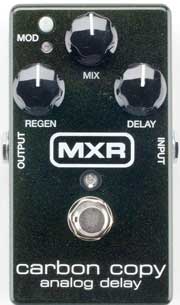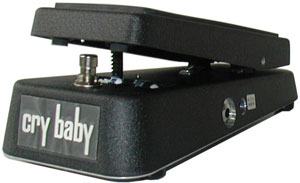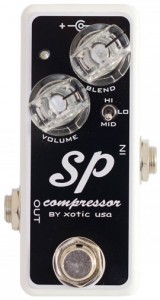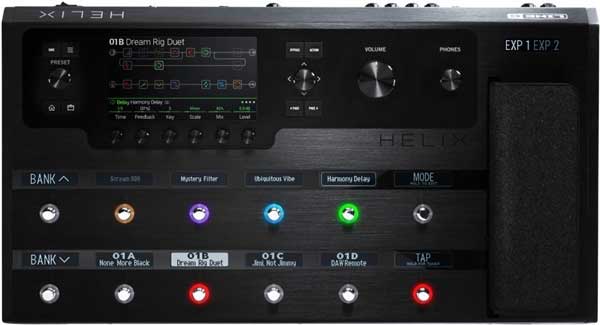Last week one of my new students went to the local guitar store to buy a few guitar pedals. He’d been learning for a while and felt it was time to start experimenting with different effects. He was really excited to get started until he saw the pedals display cabinet and felt overwhelmed with the sheer number of pedals to choose from.
In this guide, let’s look at which pedals you might want to buy when first starting out, which pedals will last you your lifetime, and how to choose the right pedals for you.
There are some pedals considered must-have and are a good choice as your first pedal choices. Three pedals a lot of guitarists consider as must-have would be a tuner, drive pedal, and delay pedal. You’ll never outgrow those pedals. If you want to take it a bit further, a lot of guitarists consider a wah pedal and a compressor as essential.
The right pedals for you depend on the type of music you play, the tone you want, and your budget. Let’s look at some must-have pedals to see what’s right for you.
What Pedals Are Must-Have
If you were to take 100 guitarists and compare their pedalboards, you might notice that while the brands and models may change from board to board, there will be some pedals that stay the same. There are some guitar pedals that you will never outgrow and will always be useful. The last thing you want is to buy your first pedal and feel like you need to upgrade it six months from now.
Guitar tuner
Even if your amp has an inbuilt tuner, a guitar tuner is a must-have pedal. Being able to stomp on a pedal to check your tuning is easier than using an amp tuner, but they’re also a handy tool when playing live. Guitar tuner pedals mute your signal when they’re activated, so they’re a quick and easy way to keep your signal muted when performing live. When a guitarist needs to switch guitars during a gig, they simply stomp on the tuner and can switch guitars in silence.
Look on any pedalboard and you’re almost guaranteed to see a guitar tuner. In the past, the most popular choice was to buy a BOSS tuner such as the TU-3. You’ll still see BOSS tuners in a lot of pedalboards because they’re reliable and built to last. But you’re more likely to see one of TC Electronic’s PolyTune pedals.
The PolyTune range has been incredibly popular mainly due to the polyphonic tuning capability. This feature allows you to strum all strings on your guitar at once and instantly see on the screen which strings are out-of-tune.
Instead of needing to go through each string individually, you can instantly find out which string is out-of-tune. Check out the price and features of the PolyTune 3 here.

The above tuner is a solid choice, but if you’re after alternatives, check out this guide on the Best Guitar Tuner Pedals. The guide digs deeper into tuners and what to look for.
Drive pedal
The most common type of pedal you’ll see on a pedalboard after a tuner is a drive pedal. Unless you play a style of music that only uses crystal-clean tones, a drive pedal is highly recommended. Drive pedals allow you to dial in different tones that your amp may not be able to produce on it’s own. Even if you like the sound of your amp’s drive channel, adding a drive pedal into the mix is a great way to take your sound in new directions.
Some guitarists use a drive pedal to give their solos a boost, some use it to smooth out the amp’s distortion, while others use it as their only drive sound. A good quality drive pedal can last a lifetime and can be incredibly useful.
There are two types of drive pedals you can get: overdrive and distortion. They’re both very similar and the difference is really only in the technical details. If you want to learn about these details, in my Guitar Effects Course I explain the difference between distortion and overdrive as well as give you audio clips comparing the two.
In 2014, I asked a number of guitar bloggers what pedals they consider ‘must-have’. One of the most common answers was for a transparent overdrive pedal. A transparent overdrive pedal is a drive pedal that doesn’t dramatically color your tone. In other words, you get a drive sound out of the pedal, but the pedal doesn’t completely change your tone to sound like a different type of guitar. It’s still your tone – just cranked up.
One of the reasons why a transparent overdrive pedal is such a popular choice is because you’re unlikely to ever grow out of it. The pedal doesn’t color your tone, so even as your tone tastes change, the pedal will still suit you.
The most popular choice for a transparent overdrive pedal was the Soul Food by EHX (check out price and features here). This pedal has been out for a long time and is still a very popular choice. It sounds great on it’s own, but also does a great job when you blend it with your amp’s drive sound.

The key point to remember here is that a drive pedal is one of the first pedals you should consider buying. Many players see them as essential – even if you like your amp’s drive tone.
For more suggestions on drive pedals, check out this guide.
Delay pedal
Delay is easily the most common type of guitar pedal you’ll see on a pedalboard after a tuner and a distortion/overdrive pedal. Delay is an effect that works on almost any style of music. A subtle delay can thicken up your tone during solos, or it can add an atmospheric quality to your clean tone. A cranked up delay can be an endless source of inspiration. A good example of how delay can inspire your playing is with slapback delay. Check out this lesson for examples on how to set up slapback delay and how to use it.
There are countless delay pedals available today. Some guitarists prefer simple analog delays that are limited in features but can give you a nice warm effect. Other guitarists prefer digital delays for the range of different delays they can produce as well as the precise control they give you over the delay. Many digital delay pedals allow you to dial in the delay to the exact millisecond you need.
If you’re after a simple delay pedal, the MXR Carbon Copy is one of the most popular analog delay pedals today. It’s a great way to add delay to your sound without having to worry about the different settings found on more complicated digital delay pedals.

If you are after a delay pedal with more features and control, check out this guide on the Best Delay Pedals. The guide explains what to look for in a delay pedal and suggests different delay pedals based on different needs.
For most guitarists, a tuner, drive pedal, and delay pedal are essential pedals. Buying these pedals first will give you a solid rig that you won’t outgrow. Some guitarists never move past these three pedals, while other guitarists go on to build large pedalboards with a range of different effects. If you’re just getting started, these pedals are good pedals to start with.
For more suggestions on must-have pedals, check out these recommendations from top guitar bloggers.
Do You Need Pedals for Guitar
While guitar pedals can be incredibly useful, not every guitarist needs them. You don’t need to have pedals to get a good tone. Some guitarists prefer plugging their guitar directly into their amp and use the amp for all the tones. Many modern amps have fantastic inbuilt effects such as the popular Fender Mustang I V2.
While you don’t need pedals for a good guitar tone, pedals can add to your tone in ways that an amp can’t. Pedals also allow you to customize your rig to the exact specifications you want. You can mix and match pedals from different brands to find the right combination that works for you. You can’t do that with an amp. An amp doesn’t give you an expressive tone like a wah pedal can. The key point to remember with pedals is they give you control. You can pick the pedals you want to use and swap out any pedals that don’t suit you. Over time as your tone preferences change, you can easily change to different pedals as you see fit while keeping your amp and guitar.
Essential Pedals for Different Styles
Apart from the above pedals, every guitarist has a different idea on what is considered an essential guitar pedal. For some guitarists, zero pedals is the right number. For others, they might feel there are ten or more pedals they consider essential.
Different styles of music make use of different types of pedals. Ambient and experimental music styles often use a wide range of pedals to create lush soundscapes and tones. Styles like jazz and blues usually stick to the basics for a more raw tone. If you’re looking for pedals to suit the style of music you play, start by checking out what pedals other guitarists in that style use.
Wah pedal
For example, if you play rock, metal, funk, blues, or similar styles, you’ll find that a lot of guitarists consider a wah pedal as essential. There are countless songs that have an iconic sound thanks to the wah pedal. If you play a style of music where a wah pedal is often used, then it makes sense to get one for yourself. There are some guitarists who only use a wah and don’t have any other pedals.

If you want to learn more about wah pedals as well as see the top wahs available today, check out this guide on Wah pedals.
Compressor
A type of pedal that’s often overlooked is a compressor. Compressors can tighten up your rhythm tone, add some punch to distorted tones, or add some sparkle to your clean tones. Funk guitarists often use compressors to give their clean tones a snappy quality. Metal guitarists use them to get a more consistent and punchy tone. Blues guitarists sometimes use them to add a bit more energy to their leads. A lot of guitarists across many different styles use compressors to enhance their tone.
I personally saw a big difference in my tone as soon as I added a compressor. For years I didn’t think compressors were needed until I plugged a Xotic SP Compressor in and heard how it improved my tone.

Just like a guitar tuner, you’re not going to outgrow a compressor pedal. Once you learn how to use it, you’ll always want one as part of your rig. To learn more about compressors, how to use them, and popular options, check out this guide on compressors.
Is a Multieffects Pedal Right For You
While single-effects pedals are incredibly popular, the other option is to buy a multi-effects pedal. The benefit with multi-effects pedals is they give you a wide range of effects all in one unit. You can access all of the above effects and more without needing to buy individual pedals for each effect. For example, the Line 6 Helix (shown below) is one of the most popular multi-effects pedals today. It offers incredible sound quality and a ridiculously long list of built-in effects.

Multi-effects pedals aren’t for everybody. Some guitarists like the simplicity of plugging a few pedals together and that’s all they need. Others like to be able to dig into presets, fine-tune each pedal’s settings, and set up different rigs for each song. Multi-effects pedals give you a level of control over your rig that just isn’t possible with single-effects pedals.
If you listen to a lot of music that uses various effects but you’re not sure which effects you want to be part of your sound, a multi-effects pedal might be worth getting. I started out with a multi-effects pedal and it was a great way to learn about all types of effects, how to use them, how to combine effects, and it allowed me to replicate effects I heard on songs without needing to buy more pedals.
I highly recommend a multi-effects pedal for guitarists who want to explore effects but don’t want to commit to buying individual pedals for each effect. Get a multi-effects pedal and you’ll have all the effects you could ever want in one unit. A good quality multi-effects unit like the Helix will last you a very long time.
Check out this guide comparing Line 6’s range of multi-effects pedals to learn about the different features to expect from a multi-effects pedal.
How To Set Up Your Pedals
Once you buy a couple of pedals, you might wonder what order to position them. Does the wah pedal go before or after the drive pedal? Which pedals go into an effects loop? Where should the compressor go in the pedal chain?
While there are general rules of thumb on the order pedals should go in, a bit of experimenting is all it takes to discover that many of those rules should be broken. Blindly following rules on pedal position isn’t a good approach. By blinding following these rules, you might miss out on a far better tone. The only way to find out what order your pedals should go in is to learn how your pedals interact with each other.
Here are some resources to help you find the perfect pedal order for your rig:
- Guide on Guitar Amp Settings: this guide explains why you should ignore presets and settings recommendations that are often shared online. Read through this guide to understand why you shouldn’t blindly follow rules when it comes to your gear
- Guitar Effects Course: this course walks you through every common type of effect, how they sound, how to control them, how they work, and how to combine them with other effects. In the examples, you will hear why you should ignore rules for pedal order and let your ears tell you what order to put them in. The course will also help you dial in and improve your tone
- Guide on The 4 Cable Method: if your amp has an effects loop (explained in the guide), you have the opportunity to dramatically improve the quality of your tone. Find out in this guide what the 4 cable method is, why it’s useful, and how to set it up
